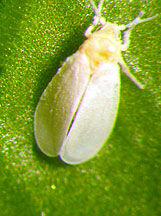skip
navigation  |
800-411-3222 (Español)
Greenhouse IPM: Sustainable Whitefly ControlPest Management Technical Note |
| By Lance Greer NCAT Agriculture Specialist Published 2000 ATTRA Publication #IP168 |
The
printable PDF version of the entire document is available
at: http://attra.ncat.org/attra-pub/PDF/ghwhitefly.pdf 12 pages — 219K Download Acrobat Reader |
Abstract
This publication focuses on integrated pest management for greenhouse whitefly on both vegetable and ornamental crops. It is designed to complement the ATTRA publication Integrated Pest Management for Greenhouse Crops, which discusses techniques for good greenhouse supervision. Monitoring of whiteflies, biological controls, biopesticides, and insect growth regulators are discussed below. The appendices include information on the newest biopesticides and biological control organisms. Table of Contents
IntroductionWhiteflies began showing resistance to synthetic insecticides early on, and by the 1980s they were a very serious greenhouse pest. Not only do they feed on plants, but they also produce honeydew, which detracts from the plants' appearance and attracts other insects and sooty mold. Whiteflies can also transmit plant viruses. The mere presence of whiteflies in a greenhouse will stop customers from buying your product. Several species of whiteflies attack greenhouse plants, and they typically have a wide host range and resist insecticides. Greenhouse tomatoes and poinsettias are especially plagued by whiteflies. The most common whiteflies on greenhouse crops are the greenhouse whitefly (Trialeurodes vaporariorum), sweetpotato whitefly (Bemisia tabaci) and the silverleaf whitefly (Bemisia argentifolii). The various whitefly species and biotypes look very much alike, but they have subtle physiological differences. These differences can cause them to respond differently to control strategies. Because control measures must be selected according to the type of whitefly present, accurate identification is critical to successful control. The Cooperative Extension Service is an excellent resource for assistance with pest identification. There are also several Web sites that provide pictures of the various whiteflies. See the Web Sites section for more information. Crop Scouting and TrappingPlants should be visually inspected for signs of a whitefly infestation—e.g., off-color or stunted plants. A hand lens is useful for systematically inspecting a number of individual plants for the presence of eggs, nymphs or adults. Both the upper and lower leaf surfaces should be inspected. It is important to check the greenhouse in the same pattern on each scouting trip. Locations where whiteflies are found should be flagged so that population development and control efforts can be evaluated. Scouting frequency should be increased during warm weather as whitefly populations multiply faster then. Trapping with yellow sticky cards, both inside and outside the greenhouse, is essential for a successful whitefly management program. The cards are used to detect and monitor population levels. As a general rule, 1 to 4 cards spaced evenly throughout 1000 square feet of greenhouse are sufficient. (1) A generally acceptable threshold for whiteflies is 0.5 per card per day when the crop is young, and 2 per card per day as the crop reaches maturity. (2) Traps should be hung level with the tops of the plants since whiteflies are most attracted to young foliage. Doors, vents and other openings where whiteflies can enter the greenhouse are other good sites to hang yellow sticky cards. Researchers in California have successfully used silver-painted pot spaces and silver polyethylene mulch to control whiteflies on greenhouse poinsettias. (3) The reflective materials were used in conjunction with yellow sticky cards or tape and resulted in significantly enhanced trapping of whiteflies, relative to controls with sticky traps only. Greenhouse plastics themselves may have significant influence on the initial attraction of insects into greenhouses. A study from the late 1990s showed that silverleaf whiteflies preferred to enter greenhouses covered with film that transmitted higher levels of ultraviolet light. (4) Biological ControlSeveral types of beneficial organisms are available for biological control of whiteflies. The parasitic wasp Encarsia formosa preys on immature whiteflies and is commonly used for greenhouse whitefly. Encarsia wasps kill whitefly nymphs in one of two ways: they either lay an egg inside the nymph, providing food for their young, or they kill the nymph right away and feed on the fluids inside of it. (2) Greenhouse whitefly pupae that have been parasitized by Encarsia formosa turn black; silverleaf whitefly pupae turn amber-brown. (2) The cost of E. formosa is comparable to foliar pesticides. (2) Sweetpotato and silverleaf whiteflies are not well controlled by Encarsia formosa. Two other wasp parasites, Encarsia luteola and Eretmocerus californicus are commercially available for control of these species, but E. formosa remains the mainstay of most whitefly biological control programs due to the expense and intermittent availability of these other beneficials. (5) Researchers are also examining different strains of E. formosa to determine their effectiveness against sweetpotato and silverleaf whiteflies. Mark Hoddle, University of California, Riverside, has done some recent research dealing with Eretmocerus eremicus. E. eremicus was effective for silverleaf whitefly control and is best used in combination with the insect growth regulators Precision™ or Applaud™. Enstar™ was not compatible with natural enemies he tested. Biological control should be used only at low whitefly levels (less than one nymph per 10 cuttings) and must be regularly evaluated. (6) Mark has also compared the effectiveness of Encarsia formosa and Eretmocerus californicus on silverleaf whitefly. In a 1996 study, both parasitoids controlled whiteflies at a 99% control rate. However, fewer numbers of E. californicus had to be released, which would result in cost savings for growers. Another benefit: Fewer parasitoids meant more food for each, so the reproduction rate was much higher. (7) Delphastus pusillus, sometimes called the whitefly destroyer, is a very small, black ladybird beetle that attacks all stages of whiteflies, but prefers eggs and nymphs. The females lay their eggs within clusters of whitefly eggs. Adults can consume 160 eggs or 12 large nymphs every day. A larva consumes 1000 whitefly eggs during its development. These beetles perform best at temperatures between 65 and 90°F, with relative humidity above 70%. These predators can be used in combination with Encarsia species. (8) See Appendix 1 for a complete listing of biological controls for whiteflies. Biorational PesticidesSome microorganisms also control whiteflies. For instance, the fungus Beauveria bassiana (trade names Naturalis-O™ and BotaniGard™), is effective against eggs, immature and adult whiteflies. Thorough coverage of leaf undersides and correct timing of applications result in best control. Another fungus, Paecilomyces fumosoroseus (trade name PFR-97™), is now commercially available. It controls whiteflies, aphids, and spider mites. Both B. bassiana and P. fumosoroseus need high humidity for best results. Several least-toxic, or biorational, pesticides have been evaluated for their effectiveness against the different whitefly species. These include neem-based formulations (Neemazad™ and Azatin™ are two registered products), insecticidal soap (M-Pede™), and horticultural oil. Enhanced whitefly control is achieved with thorough spray coverage. Wider plant spacing and removal of dead lower leaves improve pesticide coverage and pest control. A 1995 study conducted in Florida compared the effectiveness of Sunspray Ultra-Fine Spray Oil™, M-Pede insecticidal soap, a sucrose ester extract surfactant derived from tobacco, and Garlic Barrier™, for killing and repelling silverleaf whiteflies (Bemisia argentifolii) on tomatoes. Sunspray provided the best control, followed by M-Pede and the tobacco surfactant. The Garlic Barrier did not provide any control. (9) Researchers at Ohio State University showed that mortality rates of silverleaf whitefly were higher when BotaniGard was used together with Adept™ (an insect growth regulator), insecticidal soaps, horticultural oil, Fulex SO-2000, glycerol and a yeast extract. (10) In most cases, the rate of infection and kill was faster than with BotaniGard alone. This is important because it would allow more biopesticides and biorationals to be used retroactively. When several substances are used together, they are applied at lower-than-recommended rates (one-tenth to one-half were used in this study). The researchers are trying to "develop management guidelines on spray-tank mixes that would enhance fungal efficacy." (10) See Appendix 2 for a complete listing of biopesticides and biorational pesticides available for whitefly management. Insect Growth RegulatorsInsect growth regulators (IGRs) are another least-toxic pesticide control option. IGRs typically kill insects by disrupting their development. They have a complex mode of action that precludes insects from rapidly developing resistance. IGRs can work in one of several ways: 1) they can mimic juvenile hormones, so that insects never enter the reproductive stage of development; 2) they can interfere with the production of chitin, which makes up the shell of most insects; or 3) they can interfere with the molting process.
IGRs usually work through ingestion, so good spray coverage is essential. They generally don't affect non-target species-such as humans, birds, fish or other vertebrates. For most IGRs there are minimal re-entry restrictions. IGRs typically take several days to have an effect on pest populations. Because IGRs do not affect mature insects, adult beneficials released into the greenhouse after an IGR application are not likely to be affected. Use of IGRs is generally prohibited by organic certification organizations because the products are synthetic. IGRs can sometimes be used in conjunction with biological control efforts and may provide growers with a "safety net" should beneficials fail to keep the pests below economically damaging levels. The table above lists some well-known insect growth regulators. Controlled AtmosphereChanging the composition of the atmosphere in the greenhouse by either reducing oxygen or increasing carbon dioxide appears to provide some control of greenhouse whiteflies, especially adults. Reduced-oxygen experiments by Dr. Susan Han at the University of Massachusetts resulted in 100% adult mortality after less than two hours of exposure, though eight-hour treatments were needed to control most (about 80%) of the eggs and pupae. (11) Horticulturists at North Carolina State University reported that whitefly population levels were lower in greenhouses where carbon dioxide enrichment occurred daily for about eight hours. The likely reason for the population reductions is that plants grown in atmospheres with high carbon dioxide levels tend to have higher concentrations of carbohydrates in the plant tissue relative to nitrogen, resulting in a nitrogen-dilute diet for the whiteflies. Lower dietary nitrogen would slow the growth and reproduction of the pests, without adversely affecting crop yields or quality. (12) References
Web SitesInformation on silverleaf whitefly from the University of Florida
Suppliers
Appendix 1: Beneficial Organisms
Appendix 2: Biorational Pesticides
Greenhouse IPM: Sustainable Whitefly Control
|
|||||||||||||||||||||||||||||||||||||||||||||||||||||||||||||||||||||||||||||||||||||||||||||||||||||||||||||||||||||||||||||||||||||||||||||||||||||||||||||||||||||||||||||||||||||||||||||||||||||||||||||||||||||||||||||
|
Site Map | Comments | Disclaimer | Privacy Policy | Webmaster Copyright © NCAT 1997-2008. All Rights Reserved. | |||||||||||||||||||||||||||||||||||||||||||||||||||||||||||||||||||||||||||||||||||||||||||||||||||||||||||||||||||||||||||||||||||||||||||||||||||||||||||||||||||||||||||||||||||||||||||||||||||||||||||||||||||||||||||||



